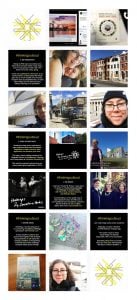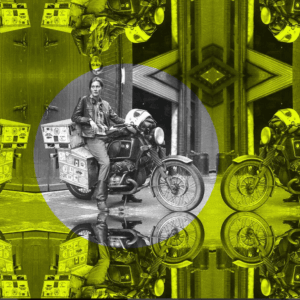Wise reflection and advice can be as valuable to your future self as it is to your younger self, says Cristina Garduño Freeman.

Dear (just a few weeks) younger self:
Remember when you wrote those Instagram posts for Parlour? That was just a few weeks back. You were #thinkingoutloud, feeling wise and reflective after having successfully completed several challenging adventures: that international trip to be a visiting scholar at Columbia University, New York; a major grant application, a symposium and your first book; and the launch of a short film series where you bravely debuted as host. In those Instagram posts you shared your experience of academia and the way ups follow downs that become ups again.

For those who didn’t catch those posts a few weeks ago, I should introduce myself. I am a late-stage early-career academic in the fields of architecture, heritage and media. Basically, it means I finished my PhD between four and five years ago and have been employed at a university during that time. The posts I shared aimed to articulate lessons learned and link them to successes. But since hosting the @_Parlour Instagram account, I’ve also had a number of weeks of feeling tired and overwhelmed – not quite the persona I portrayed in those social media posts – and this realisation made me consider how to approach writing this letter…
Heritage is about time; it is founded on the belief that the culture of the past must be preserved for the generations of the future. Conveniently, this tenet skips over the present, yet the present can never be omitted. Being aware of this conundrum simply makes you realise that today is the future of yesterday and the past of tomorrow.
Time is also a central feature of the epistolary form of ‘Letters to my Younger Self’. In this reflective literary activity, the writer creates a representation of the self that is accomplished, wise, reflective, confident. From this position, advice can be served to the younger, naïve version to counter the angst and fear that has been experienced. The form allows us to see how it ‘all turned out ok in the end’, that ‘it was all worthwhile’ and that our efforts ‘eventually paid off’. But there is a problem with this. In using this epistolary form, we position ourselves free from the struggles and challenges of the past, as if they have been overcome, and we have reached a phase that is beyond them. But as I discovered in the weeks after that onslaught of academic challenges (both intellectual and, frankly, of plain ordinary chutzpah), the reality is not quite as neatly sewn up.
So, I think that as well as the ‘Letter to my Younger Self’ we also need the ‘Letter to my Future Self’. While at one point we are buoyant, confident and feeling successful, this will probably wane as new challenges (big and small) inevitably arise. Letters that address the past and the future at once acknowledge the gaps between these two representations of the self – the ones actually sitting at the computer, trying to write an interesting piece, that need to be reminded that the feeling of success or confidence or wise reflection is not a permanent state, but rather a moment in time. And whilst it might not be here right now, it will more than likely return (hopefully) before too long. So, here goes…
Dear future/past older/younger self,
I am not sure how you are feeling right now. I can’t know whether you are facing challenges or enjoying recent accomplishments. Either way I hope this letter gives you some temporal perspective that is useful.
1. Share your ideas
Sometimes it is hard to feel your ideas have value or that they fit in with the status quo. But, while you can hear others out, you can’t escape who you are, what you know and therefore what perspective you can bring to a discussion.
Earlier this year I had the pleasure of co-convening the Dubious Heritage symposium with Professor Hannah Lewi. The symposium drew people in practice and government together with students and academics to talk about the complex problems of recognising industrial places that challenge accepted ideas about heritage.
This opportunity came about as part of my role in ACAHUCH. But it is also the result of several years of sharing ideas. Firstly, Hannah was my PhD examiner. After finishing I asked Hannah for advice and she kindly offered it. I also gave a short presentation for one of her subjects and applied for a research fellowship with her (not my current position). Each of these moments helped develop the collegiate relationship that led to a successful symposium.
So, keep sharing ideas and developing connections with others. You may not be sure how they will come to fruition, but over time they will likely lead somewhere.
2. Be Brave
It takes courage to do new things. Especially things you may not have necessarily pictured yourself doing. Job criteria don’t necessarily say this, but there are real advantages to doing things that make you nervous.
Last time I hosted Parlour I was about to launch a campaign through Deakin’s crowdfunding program, Research my World an initiative started by Professor Deb Verhoeven. Crowdfunding is a very public way to raise research funds. It is nerve-wracking and forces you to pitch your ideas widely. And this was my second campaign, but as an early career academic it has helped me get started.
I was grateful to be raising funds for Hubcaps to Creative Hubs with Dr Fiona Gray, Creative Geelong and TV writer producer Nicholas Searle. It’s much easier in a team. While we were successful in raising funds, the project was by no means straight forward. Films are a non-traditional kind of academic outcome, and soon afterwards I changed institutions and Fiona took an alt-academic job. So yes, the result is that it’s me playing host. Being brave means stretching your comfort zone, for sure. The project is now part of the Culture Victoria collection, where you can read about the project and watch the films.
So, on that basis, when I was asked to write this piece, I said yes. I also said yes to my first keynote later this year, to my first project review article in a well-known architecture publication, and to marking my first PhD recently. I’ve not done any of these things before and each one brings with it doubt. But even though it’s challenging, these are all opportunities to be brave.
3. Find Opportunity
Be an opportunist. See where unexpected possibilities can take you. Look through failure and (after you’ve had a chance to be grumpy and self-righteous) try to see how it is a small part of a much longer trajectory.
Academia brings many applications, many rejections and some successes. Regardless of each outcome, each application can advance your work. This year I was a visiting scholar at the Graduate School of Architecture, Planning and Preservation at Columbia University, New York. This, like so many other things I’ve described so far, was the eventual outcome from an unsuccessful grant application in 2016. While I had no funding, I had been accepted to an internationally recognised institute for architecture and heritage (in the USA it’s preservation). In time I developed a smaller more modest project and gained enough funding for a short but extremely valuable stint in the Big Apple.
It’s not easy, but try to remember that each submission or application is a small success regardless of the actual outcome. Try to see how each unsuccessful step can contribute to the next (hopefully) successful one. At first, I would feel really upset at each failed grant application or rejected abstract. But now I know that in time they will come to fruition, maybe not quite as I originally imagined, but they will happen nonetheless.
4. Be Persistent
Just. Keep. Swimming. Steadily. And with some time to relax in between consistent effort. Doing my PhD was not a breeze and there were moments when I truly wasn’t sure if I was going to finish. But the experience did teach me to just … keep … going.
In September last year I published my first book. It is a revised version of that pesky PhD, which gave me so much trouble in the last couple of years. I think my supervisors, friends and family were also not sure it if would ever end. I’ll never know for sure, but I after I had handed my PhD thesis in for examination a friend found this had turned up in ‘Postsecret’, an online art project where people mail in their secrets anonymously on one side of a postcard.

I couldn’t have accomplished this, or many other things over the last few years, without learning to be persistent. I know it’s always easier to see this in retrospect than at the time. And that keeping going is actually one of the hardest things to do! But it’s worth it… in the end future/past. Oh, and yes, Nicholas is my other half, and yes I was posting on Facebook from his computer. 😉
So Cris, just keep #thinkingoutloud. It doesn’t matter that it takes several attempts (about five writing sessions to be exact) to get your ideas out. See, you’ve done it.
Cristina Garduño Freeman is a Postdoctoral Research Fellow in the Australian Centre for Architectural History, Urban and Cultural Heritage (ACAHUCH) at the Faculty of Architecture, Building and Planning at the University of Melbourne. Prior to entering academia she practised in architecture, landscape architecture, urban design and visual communication. She was born in Mexico, grew up in Australia, and has two children.






















